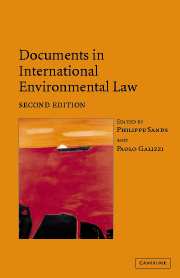Book contents
- Frontmatter
- Contents
- Preface
- PART I General instruments
- PART II Atmosphere
- PART III Oceans: global
- PART IIIB Oceans: regional
- PART IV Freshwater resources
- PART V Biodiversity
- PART VIA Hazardous substances and activities: nuclear
- PART VIB Hazardous substances and activities: pesticides
- PART VIC Hazardous substances and activities: waste
- PART VII Human rights and the environment
- PART VIII War and the environment
- PART IX Trade and the environment
- PART X Environmental impact assessment and access to information
- PART XI Liability for environmental damage and breaches of environmental obligations
- 42 International Convention on Civil Liability for Oil Pollution Damage, 27 November 1992
- 43 International Convention on the Establishment of an International Fund for Compensation for Oil Pollution Damage, 27 November 1992
- 44 Articles on the Responsibility of States for Internationally Wrongful Acts, adopted by the International Law Commission at its fifty-third session, 2001
- 45 Convention on Civil Liability for Damage Resulting from Activities Dangerous to the Environment, 21 June 1993
- 46 International Convention on Liability and Compensation for Damage in Connection with the Carriage of Hazardous and Noxious Substances by Sea, 3 May 1996
- PART XII The Antarctic
45 - Convention on Civil Liability for Damage Resulting from Activities Dangerous to the Environment, 21 June 1993
Published online by Cambridge University Press: 05 June 2012
- Frontmatter
- Contents
- Preface
- PART I General instruments
- PART II Atmosphere
- PART III Oceans: global
- PART IIIB Oceans: regional
- PART IV Freshwater resources
- PART V Biodiversity
- PART VIA Hazardous substances and activities: nuclear
- PART VIB Hazardous substances and activities: pesticides
- PART VIC Hazardous substances and activities: waste
- PART VII Human rights and the environment
- PART VIII War and the environment
- PART IX Trade and the environment
- PART X Environmental impact assessment and access to information
- PART XI Liability for environmental damage and breaches of environmental obligations
- 42 International Convention on Civil Liability for Oil Pollution Damage, 27 November 1992
- 43 International Convention on the Establishment of an International Fund for Compensation for Oil Pollution Damage, 27 November 1992
- 44 Articles on the Responsibility of States for Internationally Wrongful Acts, adopted by the International Law Commission at its fifty-third session, 2001
- 45 Convention on Civil Liability for Damage Resulting from Activities Dangerous to the Environment, 21 June 1993
- 46 International Convention on Liability and Compensation for Damage in Connection with the Carriage of Hazardous and Noxious Substances by Sea, 3 May 1996
- PART XII The Antarctic
Summary
Editorial note
The Convention on Civil Liability for Damage Resulting from Activities Dangerous to the Environment, negotiated under the auspices of the Council of Europe, has as its object the assurance of ‘adequate’ compensation as well as prevention and reinstatement (Article 1). The Convention applies to all incidents causing damage or grave or imminent threat of damage (defined extensively so as to include injury to life, property and the environment (Article 2(7)) within the territory or jurisdiction of a Party (Article 3)). The Convention does not apply to damage arising from carriage, from nuclear substances regulated by the Paris or Vienna Convention or at least as favourable internal law (Article 4(1) and 4(2)). It also does not apply to the extent that the Convention is inconsistent with worker's compensation or social security laws (Article 4(3)).
The Convention's central provision deems an operator of an installation strictly liable for damage caused by engaging in a dangerous activity (Article 4(1)). If an incident is a continuous or series of occurrences having the same origin, or damage is the result of incidents occurring in several installations or sites where dangerous activities are conducted, all operators controlling the dangerous activity during any of the occurrences are jointly and severally liable except to the extent that an operator can show that it caused only a part of the damage (Articles 4(2), 4(3) and 11). In addition, operators of waste deposits are strictly liable where that waste causes damage (Article 7(1)).
- Type
- Chapter
- Information
- Documents in International Environmental Law , pp. 1240 - 1262Publisher: Cambridge University PressPrint publication year: 2004
- 2
- Cited by



